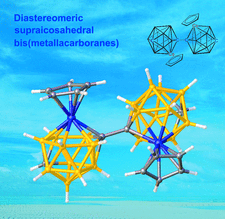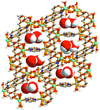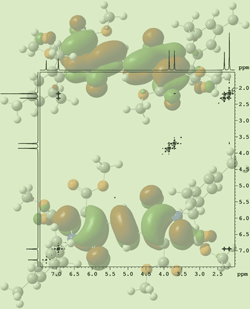issue contents
September 2015 issue

Cover illustration: The rac and meso forms of two bis(metallacarboranes) share the same overall conformation (Co-C-C'-Co' ca 136°) and show clear evidence of intramolecular steric crowding resulting in tilted cyclopentadienyl ligands. See Mandal, Man, Rosair & Welch [Acta Cryst. (2015), C71, 793-798].
research papers
Download citation


Download citation


The conformational diversity of three arylmethyl Meldrum's acids in the crystalline state has been studied. Despite the high structural similarity of these arylmethyl Meldrum's acids, the nature of the different substituents resulted in remarkable differences in both the molecular conformations and the crystal packing arrangements.
Download citation


Download citation


A manganese(II) coordination polymer, which incorporates 5-(1,3-dioxo-4,5,6,7-tetraphenylisoindolin-2-yl)isophthalate, methanol and dimethylformamide ligands, shows one-dimensional 2-connected {0} uninodal chain networks, and free dimethylformamide molecules are connected to the chains by O—H⋯O hydrogen bonds.
CCDC reference: 997495
Download citation


Download citation


A new cadmium–thiocyanate coordination polymer with an interesting structural architecture has been prepared in aqueous solution. The CdII cations are linked by bridging thiocyanate ligands to form a two-dimensional coordination polymer which lies parallel to the bc plane. Hydrogen-bonding interactions are involved in forming the three-dimensional architecture.
CCDC reference: 1415738
Download citation


Download citation


In two new 1,1′:4′,1′′-terphenyl-based diol hosts, steric shielding by terminal aromatic groups prevents molecular association by conventional hydrogen bonding, with hydroxy H atoms involved in intramolecular O—H⋯π contacts. Solvent-inclusion compounds with dimethylformamide favour the formation of strands of O—H⋯O hydrogen-bonded host and guest molecules, and with acetonitrile, the formation of a host lattice with a channel-like cavity structure incorporating the solvent molecule.
Download citation


Download citation


In two new CoII/ZnII coordination polymers based on the ligand 5-iodobenzene-1,3-dicarboxylate, that with CoII displays a twofold three-dimensional interpenetrating α-Po network and that with ZnII exhibits a two-dimensional (4,4) topological network architecture.
Download citation


Download citation


The determination of the structure of the solid-state emissive chalcone (2E)-1-(5-chlorothiophen-2-yl)-3-[4-(dimethylamino)phenyl]prop-2-en-1-one is relevant because it will play an important role in theoretical calculations to investigate potential two-photon absorption processes and could also be useful for studying the interaction of such compounds with a biological target.
CCDC reference: 1062147
Download citation


Download citation


Open  access
access
 access
accessIn two trimethylsilyl-substituted 1H-benzimidazole-2(3H)-thiones, noncovalent C—H⋯π interactions between the centroid of the benzmidazole system and the SiMe3 groups form helicoidal arrangements in one, and dimerization results in the formation of  (8) rings via N—H⋯S interactions, along with parallel π–π interactions between imidazole and benzene rings, in the second compound.
(8) rings via N—H⋯S interactions, along with parallel π–π interactions between imidazole and benzene rings, in the second compound.
Download citation


Download citation


The rac and meso forms of two bis(metallacarboranes) share the same overall conformation (Co—C—C′—Co′ ca 136°) and show clear evidence of intramolecular steric crowding resulting in tilted cyclopentadienyl ligands.
Download citation


Download citation


A zinc(II) metal–organic framework with a novel topology, formed from 4,4′,4′′-nitrilotribenzoate and 4,4′-bipyridine ligands, possesses three kinds of crystallographically independent ZnII cations, as well as binuclear Zn2(COO)4(bipy)2 paddle-wheel clusters, and can be reduced to a novel topology of a (3,3,6)-connected 3-nodal net, with the Schläfli symbol {5.62}4{52.6}4{58.87}.
CCDC reference: 1417420
Download citation


Download citation


Noncoplanar arrangements of 2,6-dichlorophenol and 2,6-dichloroaniline with respect to their coformers are favoured, which is in agreement with the frequent occurrence of structural analogues in pharmacology and biology. Additionally, the integration of these compounds into synthon-based networks enhances their ability to form two-dimensional networks, either strongly involved or just as stabilizing compounds.
Download citation


Download citation


A novel one-dimensional polymeric ZnII–dichlorobenzoate compound with isonicotinamide was synthesized and characterized by spectroscopic, structural and thermal methods. The compound is stabilized by supramolecular interactions, such as π–π and hydrogen-bonding interactions.
CCDC reference: 1417692
Download citation


Download citation


In a new cadmium–thiocyanate coordination polymer, the CdII cations are linked by nicotinic acid N atoms and by bridging thiocyanate ligands to form a two-dimensional coordination polymer which lies parallel to the bc plane. Hydrogen-bond interactions between uncoordinated solvent water molecules and the organic ligands are involved in the formation of the three-dimensional architecture.
CCDC reference: 1418674
Download citation


Download citation


The intermolecular interactions in two new phosphorothioic triamide structures are discussed using Hirshfeld surface analysis.
Download citation


Download citation


In the two-dimensional coordination polymer formed by cadmium and 5-(pyridin-4-yl)isophthalic acid, each ligand bridges three CdII cations and each CdII cation connects to three ligands to form a two-dimensional graphite-like 63 layer structure. Adjacent layers are linked via hydrogen-bonding interactions, resulting in a three-dimensional supramolecular architecture.
CCDC reference: 1019815
Download citation


Download citation


Positional isomerization (para, ortho and meta) has an effective role in the packing and intermolecular interactions of N-chlorophenyl-2-phthalimidoethanesulfonamide derivatives.


 journal menu
journal menu
































